View in other NatureServe Network Field Guides
NatureServe
Montana
Utah
Wyoming
Idaho
Wisconsin
British Columbia
South Carolina
Yukon
California
New York
Uncas Skipper - Hesperia uncas
General Description
[From Ferris and Brown 1981; Scott 1986; Layberry et al. 1998; Opler and Wright 1999; Glassberg 2001; Pyle 2002] Forewing 1.4-1.5 cm. Forewing of male with narrow stigma and black interior felt, female with dark patch in forewing cell. Uppersurface tawny-orange with dark border and basal area, forewing with white spots in the apical and submarginal areas (more extensive in females); undersurface of hindwing with white spots of postmedian band connected and forming chevron, veins usually white or silvery, submarginal patches blotchy dark brown.
Phenology
One flight, mid-June through July at high elevation and in California and Oregon; two flights, mainly June to August in the prairies; severel flights, late April to mid-September southward (Scott 1986). One-brood areas, mainly June thorugh July; two-brood areas, May to September (Glassberg 2001). Mid-June to late July in Canada (Layberry et al. 1998). May to September in the Rocky Mountain states (Ferris and Brown 1981). Late May to late August in Colorado (Scott and Scott 1978), early June to late September in North Dakota (McCabe and Post 1976), Mid-May to late June in Oregon (Pyle 2002; Warren 2005).
Diagnostic Characteristics
Best determined by a combination of the hindwing undersurface with white spots of postmedian band connected and forming chevron, veins usually white or silvery, submarginal patches blotchy dark brown.
Species Range
Montana Range
Range Descriptions
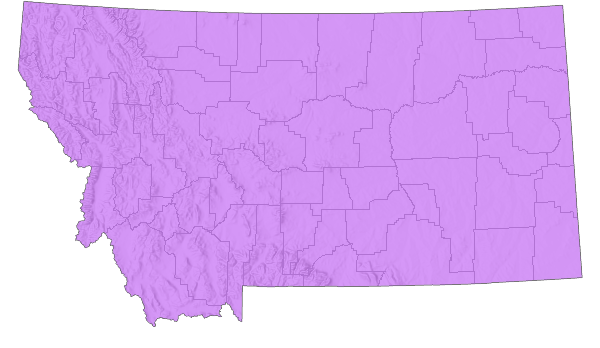
 Native
Native
Range Comments
Central Alberta east to southwestern Manitoba, south to east-central California, southeastern Arizona, southern New Mexico, western and northern Texas, western Kansas and Oklahoma (Scott 1986; Layberry et al. 1998; Opler and Wright 1999; Glassberg 2001; Pyle 2002); 1311 m to at least 3962 m elevation in Colorado (Brown 1957; Scott and Scott 1978), 1097 m to at least 1280 m elevation in Oregon (Warren 2005). In Montana, reported from at least 33 counties across the state (Kohler 1980; Stanford and Opler 1993; FLMNH Lepidopterists' Society database), from about 610 m to about 3048 m elevation. Mainly rare to uncommon (Glassberg 2001).
Observations in Montana Natural Heritage Program Database
Number of Observations: 2
(Click on the following maps and charts to see full sized version)
Map Help and Descriptions
Relative Density
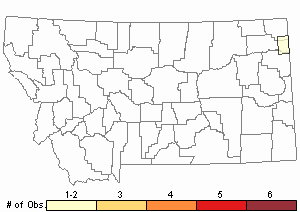
Recency
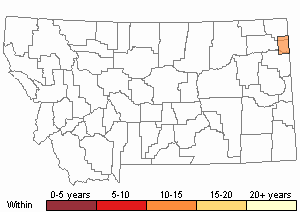
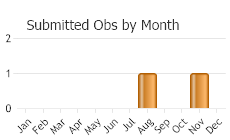

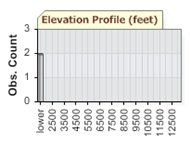 (Observations spanning multiple months or years are excluded from time charts)
(Observations spanning multiple months or years are excluded from time charts)
Migration
Non-migratory.
Habitat
Short-grass prairie, grassy alkali flats, open woodland, sagebrush, above treeline in alpine terrain (Ferris and Brown 1981; Scott 1986; Bailowitz 1988; Layberry et al. 1998; Opler and Wright 1999; Glassberg 2001; Pyle 2002; Warren 2005). Also present in prairie riparian communities dominated by grasses and open woodlands, avoiding dense Tamarix stands (Nelson and Wydoski 2008). Habitat in Montana not described, but probably similar; county records include reports from prairie grassland and pothole regions, and alpine terrain in mountains (FLMNH Lepidopteristis' Society database).
Food Habits
Larval food plants are grasses, including Achnatherum, Bouteloua (multiple species), Erioneuron, and Stipa; also Poa in captivity (Ferris and Brown 1981; Scott 1986, 1992; Layberry et al. 1998; Warren 2005). Adults feed on flower nectar (including Agoseris, Arabis, Asclepias, Astragalus, Carduus, Chrysothamnus, Cirsium, Cryptantha, Erigeron, Erysimum, Grindelia, Helianthus, Heterotheca, Hymenopappus, Liatris, Lupinus, Medicago, Monarda, Opuntia, Oxytropis, Penstemon, Potentilla, Senecio, Symphyotrichum, Tamarix, Taraxacum, Thelesperma, Verbesina) and mud (Scott 2014).
Reproductive Characteristics
Limited information. Females lay eggs singly on or near the host plant (Scott 1986, 1992). In captivity, develop from oviposition to pupae in 83-114 days, adults eclose (emerge) from pupae in captivity in 19-36 days (Scott 1975e). Larvae feed on host plant leaves, construct silk-tied leaf nests, the overwintering stage apparently unreported (Scott 1986). Males perch throughout the day on small prairie elevations, hilltops, and desert bajadas while awaiting passing females, which they pursue (Scott 1975b, 1982, 1986; Warren 2005).
Stewardship Responsibility
References
- Literature Cited AboveLegend:
 View Online Publication
View Online Publication Ferris, C.D. and F.M. Brown (eds). 1981. Butterflies of the Rocky Mountains. Univ. of Oklahoma Press. Norman. 442 pp.
Ferris, C.D. and F.M. Brown (eds). 1981. Butterflies of the Rocky Mountains. Univ. of Oklahoma Press. Norman. 442 pp. Glassberg, J. 2001. Butterflies through Binoculars: A Field Guide to the Butterflies of Western North America. Oxford University Press.
Glassberg, J. 2001. Butterflies through Binoculars: A Field Guide to the Butterflies of Western North America. Oxford University Press. Kohler, S. 1980. Checklist of Montana Butterflies (Rhopalocera). Journal of the Lepidopterists' Society 34(1): 1-19.
Kohler, S. 1980. Checklist of Montana Butterflies (Rhopalocera). Journal of the Lepidopterists' Society 34(1): 1-19. Layberry, R.A., P.W. Hall, and J.D. LaFontaine. 1998. The Butterflies of Canada. University of Toronto Press. 280 pp. + color plates.
Layberry, R.A., P.W. Hall, and J.D. LaFontaine. 1998. The Butterflies of Canada. University of Toronto Press. 280 pp. + color plates. McCabe, T.L. and R.L. Post. 1976. North Dakota butterfly calendar (including possible strays). Journal of Research on the Lepidoptera 15:93-99.
McCabe, T.L. and R.L. Post. 1976. North Dakota butterfly calendar (including possible strays). Journal of Research on the Lepidoptera 15:93-99. Nelson, S.M. and R. Wydoski.2008. Riparian butterfly (Papilionidae and Hesperioidea) assemblages assiciated with Tamarix-dominated, native vegetation-dominated, and Tamarix removal sites along the Arkansas River, Colorado, USA. Restoration Ecology 16:168-179.
Nelson, S.M. and R. Wydoski.2008. Riparian butterfly (Papilionidae and Hesperioidea) assemblages assiciated with Tamarix-dominated, native vegetation-dominated, and Tamarix removal sites along the Arkansas River, Colorado, USA. Restoration Ecology 16:168-179. Opler, P.A. and A.B. Wright. 1999. A field guide to western butterflies. Second edition. Peterson Field Guides. Houghton Mifflin Company, Boston, Massachusetts. 540 pp.
Opler, P.A. and A.B. Wright. 1999. A field guide to western butterflies. Second edition. Peterson Field Guides. Houghton Mifflin Company, Boston, Massachusetts. 540 pp. Pyle, R.M. 2002. The butterflies of Cascadia: a field guide to all the species of Washington, Oregon, and surrounding territories. Seattle Audubon Society, Seattle, Washington. 420 pp.
Pyle, R.M. 2002. The butterflies of Cascadia: a field guide to all the species of Washington, Oregon, and surrounding territories. Seattle Audubon Society, Seattle, Washington. 420 pp. Scott, J.A. 1975b. Mate-locating behavior of western North American butterflies. Journal of Research on the Lepidoptera 14:1-40.
Scott, J.A. 1975b. Mate-locating behavior of western North American butterflies. Journal of Research on the Lepidoptera 14:1-40. Scott, J.A. 1975e. Early stages of seven Colorado Hesperia (Hesperiidae). Journal of the Lepidopterists' Society 29:163-167.
Scott, J.A. 1975e. Early stages of seven Colorado Hesperia (Hesperiidae). Journal of the Lepidopterists' Society 29:163-167. Scott, J.A. 1982. Mate-locating behavior of western North American butterflies. II. New observations and morphological adaptations. Journal of Research on the Lepidoptera 21(3): 177-187.
Scott, J.A. 1982. Mate-locating behavior of western North American butterflies. II. New observations and morphological adaptations. Journal of Research on the Lepidoptera 21(3): 177-187. Scott, J.A. 1986. The butterflies of North America: a natural history and field guide. Stanford University Press, Stanford, California.
Scott, J.A. 1986. The butterflies of North America: a natural history and field guide. Stanford University Press, Stanford, California. Scott, J.A. 1992. Hostplant records for butterflies and skippers (mostly from Colorado) 1959-1992, with new life histories and notes on oviposition, immatures, and ecology. Papilio new series #6. 185 p.
Scott, J.A. 1992. Hostplant records for butterflies and skippers (mostly from Colorado) 1959-1992, with new life histories and notes on oviposition, immatures, and ecology. Papilio new series #6. 185 p. Scott, J.A. 2014. Lepidoptera of North America 13. Flower visitation by Colorado butterflies (40,615 records) with a review of the literature on pollination of Colorado plants and butterfly attraction (Lepidoptera: Hersperioidea and Papilionoidea). Contributions of the C.P. Gillette Museum of Arthopod Diversity. Fort Collins, CO: Colorado State University. 190 p.
Scott, J.A. 2014. Lepidoptera of North America 13. Flower visitation by Colorado butterflies (40,615 records) with a review of the literature on pollination of Colorado plants and butterfly attraction (Lepidoptera: Hersperioidea and Papilionoidea). Contributions of the C.P. Gillette Museum of Arthopod Diversity. Fort Collins, CO: Colorado State University. 190 p. Scott, J.A. and G.R. Scott. 1978. Ecology and distribution of the butterflies of southern central Colorado. Journal of Research on the Lepidoptera 17(2): 73-128.
Scott, J.A. and G.R. Scott. 1978. Ecology and distribution of the butterflies of southern central Colorado. Journal of Research on the Lepidoptera 17(2): 73-128. Stanford, R.E. and P.A. Opler. 1993. Atlas of western USA butterflies: including adjacent parts of Canada and Mexico. Unpubl. Report. Denver and Fort Collins, Colorado 275 pp.
Stanford, R.E. and P.A. Opler. 1993. Atlas of western USA butterflies: including adjacent parts of Canada and Mexico. Unpubl. Report. Denver and Fort Collins, Colorado 275 pp. Warren, A.D. 2005. Lepidoptera of North America 6: Butterflies of Oregon, their taxonomy, distribution, and biology. Contributions of the C. P. Gillette Museum of Arthropod Diversity, Colorado State University. Fort Collins, Colorado. 406 pp.
Warren, A.D. 2005. Lepidoptera of North America 6: Butterflies of Oregon, their taxonomy, distribution, and biology. Contributions of the C. P. Gillette Museum of Arthropod Diversity, Colorado State University. Fort Collins, Colorado. 406 pp.
- Additional ReferencesLegend:
 View Online Publication
View Online Publication
Do you know of a citation we're missing? Allen, T.J., J.P. Brock, and J. Glassberg. 2005. Caterpillars in the field and garden: a field guide to the butterfly caterpillars of North America. Oxford University Press.
Allen, T.J., J.P. Brock, and J. Glassberg. 2005. Caterpillars in the field and garden: a field guide to the butterfly caterpillars of North America. Oxford University Press. Brock, J.P. and K. Kaufman. 2003. Kaufman Field Guide to Butterflies of North America. Houghton Mifflin Company, New York, NY 284 pp.
Brock, J.P. and K. Kaufman. 2003. Kaufman Field Guide to Butterflies of North America. Houghton Mifflin Company, New York, NY 284 pp. Forister, M.L., C.A. Halsch, C.C. Nice, J.A. Fordyce, T.E. Dilts, J.C. Oliver, K.L. Prudic, A.M. Shapiro, J.K. Wilson, J. Glassberg. 2021. Fewer butterflies seen by community scientists across the warming and drying landscapes of the American West. Science 371:1042-1045.
Forister, M.L., C.A. Halsch, C.C. Nice, J.A. Fordyce, T.E. Dilts, J.C. Oliver, K.L. Prudic, A.M. Shapiro, J.K. Wilson, J. Glassberg. 2021. Fewer butterflies seen by community scientists across the warming and drying landscapes of the American West. Science 371:1042-1045. Forister, M.L., E.M. Grames, C.A. Halsch, K.J. Burls, C.F. Carroll, K.L. Bell, J.P. Jahner, et al. 2023. Assessing risk for butterflies in the context of climate change, demographic uncertainty, and heterogeneous data sources. Ecological Monographs 93(3):e1584. https://doi.org/10.1002/ecm.1584
Forister, M.L., E.M. Grames, C.A. Halsch, K.J. Burls, C.F. Carroll, K.L. Bell, J.P. Jahner, et al. 2023. Assessing risk for butterflies in the context of climate change, demographic uncertainty, and heterogeneous data sources. Ecological Monographs 93(3):e1584. https://doi.org/10.1002/ecm.1584
- Web Search Engines for Articles on "Uncas Skipper"
- Additional Sources of Information Related to "Insects"





